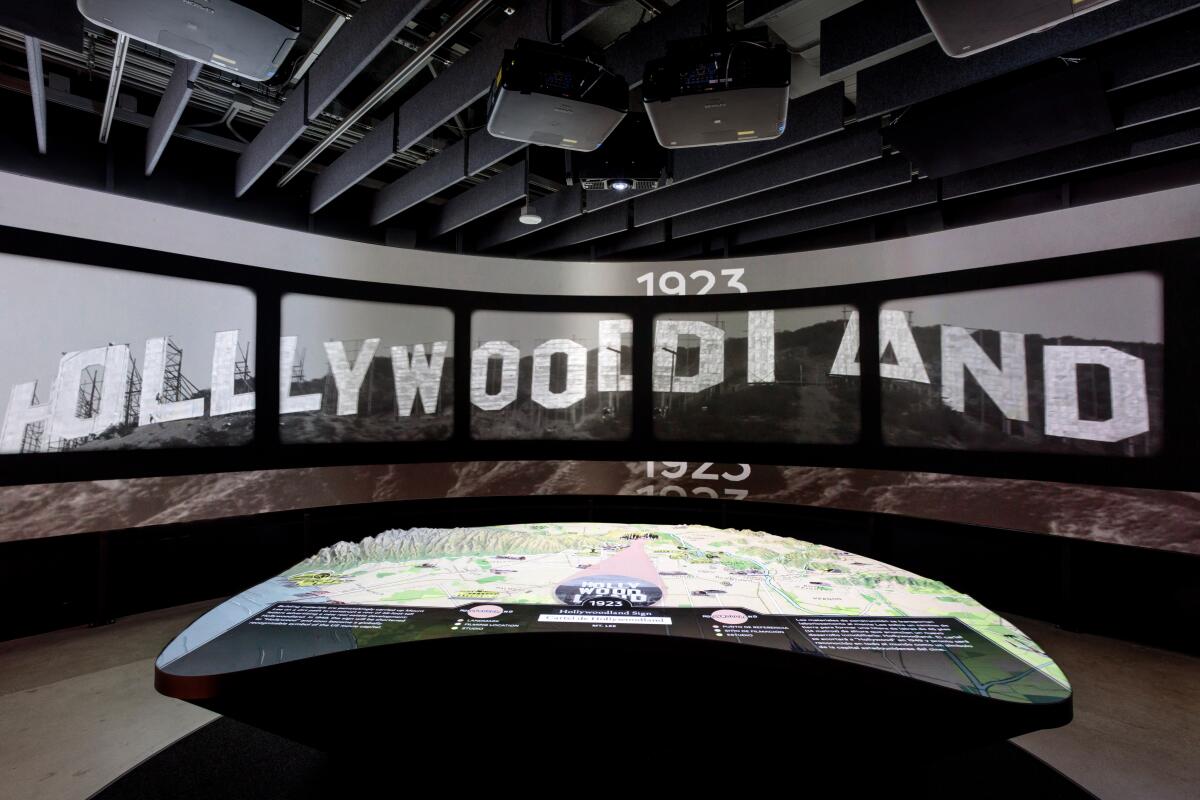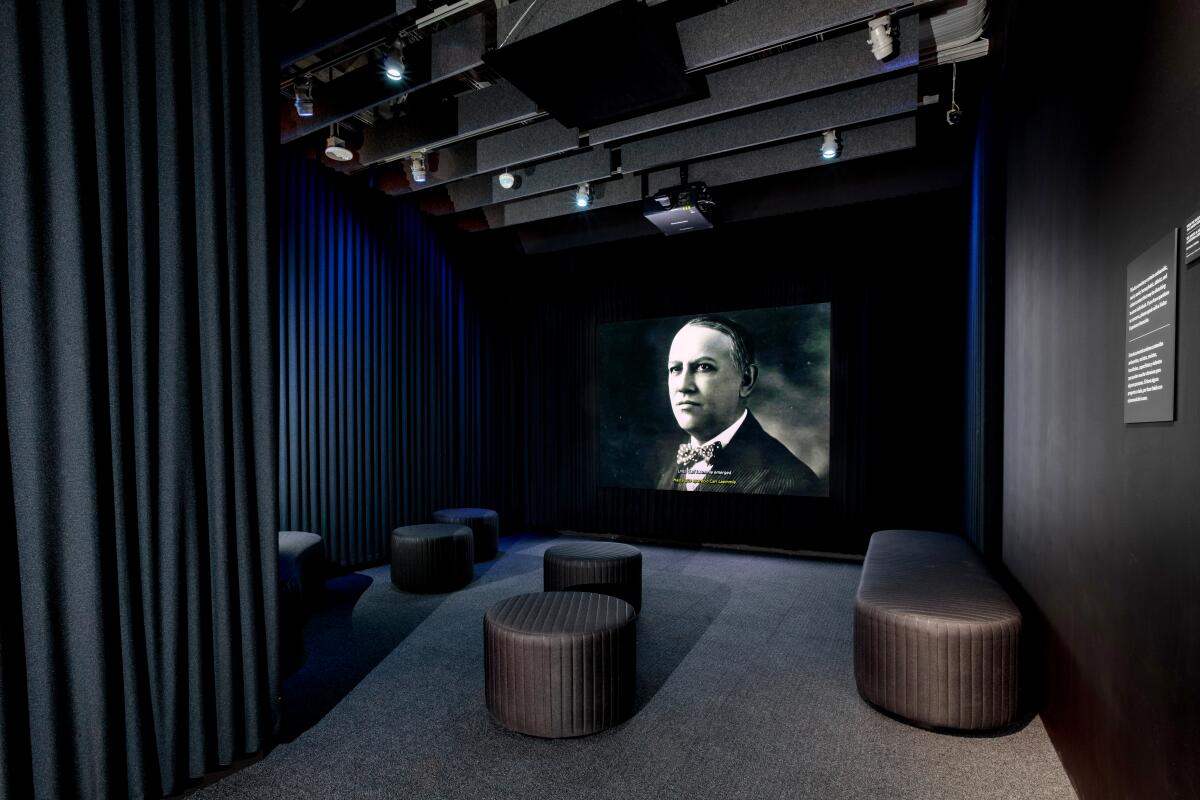Schmuel Gelbfisz, Lazar Meir and the Wonsal brothers are not names that immediately come to mind when thinking about Hollywood legends, but Samuel Goldwyn, Louis B. Mayer and the Warner brothers are.
These monumental Hollywood figures changed their given Jewish names to ones they thought would be more palatable to Americans in the early 20th century in hopes of increasing their chances of success. While their studios had tremendous accomplishments, creating some of the best films of all time, these men’s birth names are not widely known.
The Academy Museum is aiming to change that.
A new exhibition titled “Hollywoodland: Jewish Founders and the Making of a Movie Capital,” which opens Sunday to the public, explores the stories of the Jewish filmmakers and studio founders who helped cement the Los Angeles area as the world capital of entertainment. It will be the museum’s first permanent exhibition.
“We want people to come away with a richer understanding of how this city is so intertwined with this industry and also a deeper understanding of why this is specifically a Jewish immigrant story,” said Dara Jaffe, an associate curator at the Academy Museum, who spearheaded the exhibition.
The immersive exhibition traces the development of the major Hollywood studios and the golden age of film in the early 20th century through the perspective of Jewish immigrants who were at the heart of the industry’s establishment.
Since it opened in 2021, the Academy Museum has been dogged by criticism for scarcely highlighting or recognizing the predominantly Jewish group of filmmakers who developed the industry. The Eastern European Jewish immigrants who laid the groundwork for Hollywood and their first-generation American Jewish children were not featured in the museum’s ambitious exhibitions that emphasized and celebrated the work of groups often marginalized in Hollywood.
Jaffe said the museum had always planned to include the stories of the Jewish founders in their exhibitions eventually, but also understands the criticism over the lack of representation at the time of the museum’s opening. She said she welcomed feedback while curating the exhibition to ensure it was something the filmmaking and Jewish communities felt accurately represented the history.
“We completely feel it is foundational to who we are as a film museum, representing this industry, and it’s central to who we are as a film museum in Los Angeles,” Jaffe said. “It’s important to us that every visitor who comes can get this story of the founding of Hollywood and the Jewish studio heads.”

The exhibition weaves the stories of a developing Los Angeles and film industry with the lives of the Jewish immigrants and first-generation Jewish Americans who founded and built Hollywood as we know it.
(Joshua White / JWPictures / Academy Museum)
With the exhibition opening amid Jewish American Heritage Month and during a time of rising antisemitism, Jaffe said she wants visitors to leave the exhibition with deeper knowledge of the relationship between Jewish people and filmmaking — and to understand that the history of that relationship is not “fodder for further antisemitism.”
“There have been so many times over the past couple years where I wished this exhibition was already open so we could point to it and say, ‘Please, come learn more,’ ” Jaffe said. “It’s a relief that it finally will be open.”
Author and film critic Neal Gabler, who wrote 1988‘s “An Empire of Their Own: How the Jews Invented Hollywood,” served as an advisor on the exhibition and will speak at its opening night event. In the widely cited book, Gabler wrote that Jews often faced barriers to entry in other industries, and entertainment was a field where they saw an opportunity to develop their own business.
Gabler wrote in his introduction that Jews created “their idealized America on the screen” — with strong families led by valorous fathers, ardent patriotism and resilience — and in doing so, American values became defined by their work.
Two sections of the exhibition’s three distinct parts spotlight these Jewish founders and their respective studios — Universal, Fox (later 20th Century-Fox), Paramount, United Artists and Warner Bros., to name a few — and how they built up the idea of the American Dream.
The “Studio Origins” section features multimedia displays that detail the founding of each of “the majors,” as they were often called, and dives into the stories of their respective founders. It also explores how the studio system operated in the late 1920s through the late ‘40s, when the eight major studios dominated production and often signed long-term contracts with actors and filmmakers.

The exhibition includes a short documentary about the studio founders’ lives and their experiences of immigration and antisemitism.
(Joshua White / JWPictures / Academy Museum)
An original short-form documentary titled “From the Shtetl to the Studio: The Jewish Story of Hollywood,” focuses on the founders’ immigration stories and the challenges they faced as they built Hollywood. It details how experiencing antisemitism and oppression affected their careers. Ben Mankiewicz, the host of Turner Classic Movies and the grandson of “Citizen Kane” co-writer Herman J. Mankiewicz, narrates the documentary, which features archival images and video clips.
The exhibition also includes an animated tabletop and projections to illustrate how L.A. evolved alongside the growing film industry. The immersive display maps the city from 1902, when the first dedicated movie theater was built in L.A., through 1929, the year of the first Academy Awards. Jaffe said she wanted to make sure the exhibition “organically balanced” the stories of the founders and the city.
“Hollywood is both a place and an idea. There’s the geographic city of Los Angeles and Hollywood as a mythological symbol,” Jaffe said. “There was filmmaking in Los Angeles before the Jewish founders established the studio system, but it was truly the studio system that transformed Los Angeles into the idea of the mythological symbol of Hollywood.”

